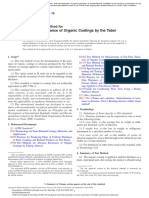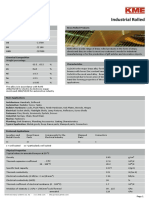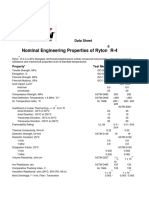Frenos Sauleda - ToP - 05
Frenos Sauleda - ToP - 05
Uploaded by
Marcos LópezCopyright:
Available Formats
Frenos Sauleda - ToP - 05
Frenos Sauleda - ToP - 05
Uploaded by
Marcos LópezOriginal Description:
Original Title
Copyright
Available Formats
Share this document
Did you find this document useful?
Is this content inappropriate?
Copyright:
Available Formats
Frenos Sauleda - ToP - 05
Frenos Sauleda - ToP - 05
Uploaded by
Marcos LópezCopyright:
Available Formats
Barri del migdia S/N - E 08396
Sant Cebrià de Vallalta (Barcelona - Spain)
sauleda@frenossauleda.com
Tel. (+ 34) 93 763 11 20 Fax (+ 34) 93 763 10 61
TOP/05
ID Material: T5
Rble: R. Antich
Revision: 5
Last updated: 06/09/2019
TOP/05 is green molded friction material which main characteristics are flexibility and a high static friction coefficient. Due to
the metal components this material is resistant to high temperatures. It consists phenolic resins with a NBR rubber bonding system, short
and brass fibres, friction modifiers and fillers. TOP/05 is semi-cured and suitable for bonding and riveting.
Material data
Friction propieties (according graphics) Material type : Flexible material
Static Friction Coefficient (15bar, from box): 0.60±0.05 μ
Appearance / Formats
Static Friction Coefficient (15bar, 100ºC): 0.60±0.05 μ
Dynamic Friction Coefficient: see charts
Wear Rate: see charts
Tº Fading: >300 °C
Applications
Physical properties
Brake pads -
Hardness (DIN53505): 45±5 Shore-D
Specific Gravity (ASTM D792): 1.6±0.05 gr/cm3
Price Level : € €€
Ignition Loss (ASTM D7348): 43±2 %
Acetone Extraction (ASTM D494): 1±0.2 %
Reach (EC)1907/2006 - RoHS 2011/65/EU : Compliance
Thermal Conductivity (ASTM E1952): 0.22±0.01 W/m°K
Others
Mechanical properties
Perlitic cast iron, hardness
Recommended Mating Surface:
HB150-200
Tensile Strength (ASTM D638): 5±2 N/mm2
Recommended Adhesives: Thermosetting adhesive
Compressive Strength (ISO 844:2014): 143±5 N/mm2
Oil Resistant: Yes
Shear Modulus (ASTM D2344-00): 175±10 N/mm2
Poisson Coefficient (ASTM D638): 0.36±0.03
Young Modulus (ASTM D638): 474±100 N/mm2
Recommended Working Values
T° Max. Continuous Operation: 250 °C
T° Max. Intermittent Operation: 350 °C
Rubbing speed, temperature and pressure are related. Changing any values will change other. The values shown represent typical conditions, but are not ultimate limits of the material.
You might also like
- Te208 enDocument4 pagesTe208 enMarian Ariciuc100% (3)
- Energy Efficiency in Motor Systems Proceedings of The 11th International ConferenceDocument748 pagesEnergy Efficiency in Motor Systems Proceedings of The 11th International Conferencedelta_scopeNo ratings yet
- D4060.37296 - Taber Abraser TestDocument6 pagesD4060.37296 - Taber Abraser TestJeremy100% (1)
- Laminated CompressDocument42 pagesLaminated CompressMACHINE-30 ISTENNo ratings yet
- Design of Commercial Building (G+3)Document68 pagesDesign of Commercial Building (G+3)avnishNo ratings yet
- Virgin Ptfe DatasheetDocument1 pageVirgin Ptfe DatasheetFelipe Zúñiga ParedesNo ratings yet
- TDS UBE NYLON 1024B, CastDocument1 pageTDS UBE NYLON 1024B, CastAlexander ShvetsNo ratings yet
- Virgin PTFE G400 Extruded - Rev.06Document1 pageVirgin PTFE G400 Extruded - Rev.06Alessio Di BellaNo ratings yet
- RX 102 BLACK GREY 9141: Linear Low Density Polyethylene: ColourDocument1 pageRX 102 BLACK GREY 9141: Linear Low Density Polyethylene: ColourEetu SatosalmiNo ratings yet
- 1917780Document3 pages1917780kaendozo0910No ratings yet
- Ultra-Soft Thermal Conductive PadDocument2 pagesUltra-Soft Thermal Conductive PadArunkumar PBNo ratings yet
- Cuzn37 Industrial RolledDocument6 pagesCuzn37 Industrial RolledcvgfgNo ratings yet
- Sikadur®-42 MP Slow HC: Product Data SheetDocument4 pagesSikadur®-42 MP Slow HC: Product Data SheetAmnart KhampanitNo ratings yet
- H48-6 / TG-AH486: Thermal PadDocument1 pageH48-6 / TG-AH486: Thermal PadMalek Ellouz (Jay)No ratings yet
- Sikadur®-42 MP Slow HC: Product Data SheetDocument4 pagesSikadur®-42 MP Slow HC: Product Data SheetCbeztNo ratings yet
- C2700Document6 pagesC2700Andrew TanNo ratings yet
- Sikadur®-42 MP Slow - PDS - GCC - AE - (07-2016) - 1 - 1Document5 pagesSikadur®-42 MP Slow - PDS - GCC - AE - (07-2016) - 1 - 1邢焕震No ratings yet
- Ptfe - G400Document1 pagePtfe - G400Alessio Di BellaNo ratings yet
- Nominal Engineering Properties of Ryton R-4: Data SheetDocument4 pagesNominal Engineering Properties of Ryton R-4: Data SheetRakeshNo ratings yet
- Sikadur - 42 MP SlowhcDocument4 pagesSikadur - 42 MP Slowhcaritamay3456No ratings yet
- 42crmo6 : Steel GradeDocument2 pages42crmo6 : Steel GradeYonas Dwiananta YuwonoNo ratings yet
- HDPE Data SheetDocument1 pageHDPE Data SheetemaNo ratings yet
- Meltio-Nickel-718 Material Datasheet PDFDocument2 pagesMeltio-Nickel-718 Material Datasheet PDFJakNo ratings yet
- Ultra Soft Thermal Pad: Features ApplicationDocument1 pageUltra Soft Thermal Pad: Features ApplicationMalek Ellouz (Jay)No ratings yet
- S 777MXXH 14Document7 pagesS 777MXXH 14amir bizhehNo ratings yet
- 1000 MM PolytheleneDocument1 page1000 MM PolytheleneJaokNo ratings yet
- Spur Gear Spec Some Manufactures Dimension PDFDocument52 pagesSpur Gear Spec Some Manufactures Dimension PDFagus wahyudiNo ratings yet
- 1401X06 Unreinforced Type / Standard: Intrduction List of Grade Technical Data (Grade) Technical Data (Porperty) TopicsDocument1 page1401X06 Unreinforced Type / Standard: Intrduction List of Grade Technical Data (Grade) Technical Data (Porperty) TopicsDeni SuhendiNo ratings yet
- T495D336K025ATE090Document1 pageT495D336K025ATE090snow69yNo ratings yet
- S-312.16 Ficha TecnicaDocument4 pagesS-312.16 Ficha TecnicaKATHERINE VIRGINIA AMARO CARRIONNo ratings yet
- 36NiCrMo16 10083 06 ENG 01Document1 page36NiCrMo16 10083 06 ENG 01Guru Raj9739No ratings yet
- Yellow: LM6 (EN 1706 AC-44100) Aluminium Casting AlloyDocument3 pagesYellow: LM6 (EN 1706 AC-44100) Aluminium Casting AlloySohail ShaikhNo ratings yet
- Datasheet BOHLER DCMS-IG TIGDocument1 pageDatasheet BOHLER DCMS-IG TIGDaniele DuarteNo ratings yet
- 12Cr12Mo 1Cr12MoDocument2 pages12Cr12Mo 1Cr12MoKashif MohiuddinNo ratings yet
- Fluteck P7500 CA v01.19Document2 pagesFluteck P7500 CA v01.19fprovitaliNo ratings yet
- 3 CR 13Document3 pages3 CR 13Ali HashemiNo ratings yet
- Nas - 185N - e - 254 Smo - Uns - S31254Document4 pagesNas - 185N - e - 254 Smo - Uns - S31254Marvin BasdenNo ratings yet
- S 787TBXH 14 - EngDocument9 pagesS 787TBXH 14 - Eng허원No ratings yet
- Filament Specifications Unit Value: All 3D Printed Parts Printed at 100% Infill and Annealed at 110ºC/20 MinDocument4 pagesFilament Specifications Unit Value: All 3D Printed Parts Printed at 100% Infill and Annealed at 110ºC/20 MinRoberto Gonzalo PelazNo ratings yet
- Sikadur 42LE Epoxy Grout DatasheetDocument5 pagesSikadur 42LE Epoxy Grout DatasheetJoshua HobsonNo ratings yet
- Manufacturing Processes and Materials ExercisesDocument2 pagesManufacturing Processes and Materials ExercisesMedSparkNo ratings yet
- SUPRA50®: Chemical Composition (Weight %)Document3 pagesSUPRA50®: Chemical Composition (Weight %)malaya tripathyNo ratings yet
- GFT Data SheetDocument1 pageGFT Data SheetDasan ThadathilNo ratings yet
- Hyundai Welding Co., LTDDocument3 pagesHyundai Welding Co., LTDblahNo ratings yet
- Calaumid 612Document1 pageCalaumid 612Sudipta GangopadhyayNo ratings yet
- Polycarbonate-ABS Blend (PC-ABS) : Mechanical Properties Test Method Imperial MetricDocument1 pagePolycarbonate-ABS Blend (PC-ABS) : Mechanical Properties Test Method Imperial MetricIsabel Narloch CardosoNo ratings yet
- Kocetal K700 Property DataDocument1 pageKocetal K700 Property DataRanjan GnanaoliNo ratings yet
- Nas 254N: (Uns S32053)Document4 pagesNas 254N: (Uns S32053)munif finumNo ratings yet
- 80 8559 01 Dowsil TC 5515 LT Low Density Thermal Conductive Gap FillerDocument5 pages80 8559 01 Dowsil TC 5515 LT Low Density Thermal Conductive Gap Fillerkrishan.chaituNo ratings yet
- NEDAL Datasheet-3003Document1 pageNEDAL Datasheet-3003Manoranjan MohapatraNo ratings yet
- (UNS N08904) : NAS High Corrosion Resistant Stainless SteelDocument4 pages(UNS N08904) : NAS High Corrosion Resistant Stainless SteelMiguel Martinez GuerreroNo ratings yet
- CuZn33 CatalogueDocument9 pagesCuZn33 CataloguefedericoNo ratings yet
- ThermaCool Gap Filler BRO 1372Document8 pagesThermaCool Gap Filler BRO 1372xingdrewNo ratings yet
- Elastomer Base Iso 1629 Colour Projected Service Temperatures Additional CodesDocument3 pagesElastomer Base Iso 1629 Colour Projected Service Temperatures Additional CodesJAn KowalskiNo ratings yet
- Nedal Alloy Datasheet EN AW 7108ADocument1 pageNedal Alloy Datasheet EN AW 7108ANico VazquezNo ratings yet
- Hydro en Aw 1050aDocument1 pageHydro en Aw 1050aManoranjan MohapatraNo ratings yet
- Polye PDocument2 pagesPolye PFranco Gabriel MercadoNo ratings yet
- 100crmnsi6-4: Steel GradeDocument3 pages100crmnsi6-4: Steel GradeSama UmateNo ratings yet
- Material Data Sheet: HDPE NaturalDocument2 pagesMaterial Data Sheet: HDPE NaturalSyed MoinNo ratings yet
- Filament Specifications Unit ValueDocument4 pagesFilament Specifications Unit ValueRoberto Gonzalo PelazNo ratings yet
- PA6G MoSDocument1 pagePA6G MoSjhax90No ratings yet
- Alloy Data Sheet En-Aw 6101B (Ealmgsib) : Type: High Conductivity Alloy)Document1 pageAlloy Data Sheet En-Aw 6101B (Ealmgsib) : Type: High Conductivity Alloy)Bouchra SonsuzaNo ratings yet
- Evolution of Advanced High-Strength Steels in Automotive ApplicationsDocument27 pagesEvolution of Advanced High-Strength Steels in Automotive ApplicationsJoao daokNo ratings yet
- CNN For Oil and Gas Flow PatternDocument6 pagesCNN For Oil and Gas Flow PatternParama DwityaNo ratings yet
- Fizzy Drinks To Ichi o Me Try LessonDocument12 pagesFizzy Drinks To Ichi o Me Try LessonEvanNo ratings yet
- Chem 120.1 Exer1 SchematicDocument5 pagesChem 120.1 Exer1 SchematicJhoel AmadoNo ratings yet
- Chemical Process Control (NOC20CH28) Week 1 Assignment: (A) TrueDocument4 pagesChemical Process Control (NOC20CH28) Week 1 Assignment: (A) TrueAmal GSNo ratings yet
- 625786fusibletermico PDFDocument24 pages625786fusibletermico PDFVentura Ramos LuqueNo ratings yet
- VOL 15-AWS Inspection Trends - 2012 - 01Document36 pagesVOL 15-AWS Inspection Trends - 2012 - 01Nguyen Duc DungNo ratings yet
- Finishing Operations Lec 4Document27 pagesFinishing Operations Lec 4AnnieMalik100% (1)
- BS AP (Instru)Document1 pageBS AP (Instru)Loraine MenorcaNo ratings yet
- Optimization of Hardness Properties of Magnesium-Based Composites by Using Taguchi Method - SpringerLinkDocument7 pagesOptimization of Hardness Properties of Magnesium-Based Composites by Using Taguchi Method - SpringerLinkVivek ChawlaNo ratings yet
- Thermodynamic Concepts and ProcessesDocument12 pagesThermodynamic Concepts and Processesae. xandpNo ratings yet
- Absolute Humidity TableDocument1 pageAbsolute Humidity Tablerajib0403050cuetNo ratings yet
- Trung Tâm Anh NG Nhung PH M 27N7A KĐT Trung Hòa Nhân Chính - 0946 530 486 - 0964 177 322Document6 pagesTrung Tâm Anh NG Nhung PH M 27N7A KĐT Trung Hòa Nhân Chính - 0946 530 486 - 0964 177 322Phạm Khắc Trung0% (1)
- SPM Physics Notes SignedDocument19 pagesSPM Physics Notes Signedkw100% (1)
- Ctfs To Dtfs To DTFTDocument3 pagesCtfs To Dtfs To DTFTNathan ImigNo ratings yet
- Nihon Kohden Bsm4100Document216 pagesNihon Kohden Bsm4100Jaime Donoso GarridoNo ratings yet
- Topic 2 (Resistor) : Name: Amelinda Azalia Savira Class: EK-3ADocument3 pagesTopic 2 (Resistor) : Name: Amelinda Azalia Savira Class: EK-3Avira amelindaNo ratings yet
- MICREC1 Complete Lecture Notes - TermDocument168 pagesMICREC1 Complete Lecture Notes - TermdsttuserNo ratings yet
- Berryman, Sylvia - Galen and The Mechanical Philosophy - Apeiron, 35, 3 - 2002 - 235-254Document20 pagesBerryman, Sylvia - Galen and The Mechanical Philosophy - Apeiron, 35, 3 - 2002 - 235-254the gatheringNo ratings yet
- Building Energy Auditing: Energy Assessment and Savings Opportunity IdentificationDocument236 pagesBuilding Energy Auditing: Energy Assessment and Savings Opportunity IdentificationPCGNo ratings yet
- Instructions: Mixer ManualDocument46 pagesInstructions: Mixer ManualJose VidalNo ratings yet
- Analysis and Design of Multi Storied Building by Using Etabs SoftwareDocument2 pagesAnalysis and Design of Multi Storied Building by Using Etabs SoftwareShakeel EngyNo ratings yet
- A Textbook of MetallographyDocument376 pagesA Textbook of Metallographyanon_563370781No ratings yet
- Calculation of Cable SizingDocument10 pagesCalculation of Cable SizingRusdianto MuhammadNo ratings yet
- FLENDER - 2LP3021-0BJ50-6ZA0-Z - B41+C00+C82+G30+G36+H00+H10+P0B+P14+P88+P95+Y01+Y02+Y20+Y21+Y23 - Datasheet - enDocument3 pagesFLENDER - 2LP3021-0BJ50-6ZA0-Z - B41+C00+C82+G30+G36+H00+H10+P0B+P14+P88+P95+Y01+Y02+Y20+Y21+Y23 - Datasheet - enoscar_jfrNo ratings yet
- Electricity & ElectronicsDocument82 pagesElectricity & ElectronicsCassandra Noreen Pacayra SantosNo ratings yet

























































































